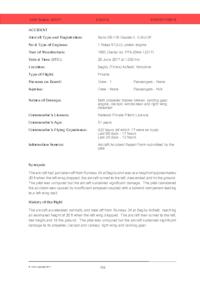
This information is added by users of ASN. Neither ASN nor the Flight Safety Foundation are responsible for the completeness or correctness of this information.
If you feel this information is incomplete or incorrect, you can submit corrected information.
| Date: | Tuesday 20 June 2017 |
| Time: | 12:30 UTC |
| Type: |  Rans S-6-116 Coyote II |
| Owner/operator: | Private |
| Registration: | G-BUOK |
| MSN: | PFA 204A-12317 |
| Year of manufacture: | 1993 |
| Engine model: | Rotax 912-UL |
| Fatalities: | Fatalities: 0 / Occupants: 1 |
| Other fatalities: | 0 |
| Aircraft damage: | Destroyed |
| Category: | Accident |
| Location: | Bagby Airfield, Bagby, Thirsk, North Yorkshire -
 United Kingdom United Kingdom
|
| Phase: | Take off |
| Nature: | Private |
| Departure airport: | Bagby Airfield (EGNG) |
| Investigating agency: | AAIB |
| Confidence Rating: |
Rans S-6-116 Coyote II G-BUOK: Written off (damaged beyond repair) when stalled immediately after takeoff in tailwind conditions, at Bagby (Thirsk) Airfield, Yorkshire, 20 June 2017. According to following excerpt from the official AAIB report into the accident...
"The aircraft had just taken off from Runway 24 at Bagby and was at a height of approximately 20 feet when the left wing dropped, the aircraft turned to the left, descended and hit the ground. The pilot was uninjured but the aircraft sustained significant damage. The pilot considered the accident was caused by insufficient airspeed coupled with a tailwind component leading to a left-wing stall.
The aircraft accelerated normally and took off from Runway 24 at Bagby Airfield, reaching an estimated height of 20 ft when the left wing dropped. The aircraft then turned to the left, lost height and hit the ground. The pilot was uninjured but the aircraft sustained significant damage to its propeller, cockpit and canopy, right wing and landing gear.
The Rans S6, fitted with a Rotax 912 engine in this case, should have been capable of getting airborne with a takeoff run of 60 m. It has a cruising speed of 90 kt and a relatively low stall speed of 35 kt. With minimal or no headwind, the airfield conditions would mean the aircraft could have easily taken off and achieved a safe airspeed well before the concrete section of the runway. However, as the pilot stated; “the probable cause for a wing stall was not enough airspeed for the wind conditions, coupled with a gusting tailwind”.
It is likely that the pilot, mindful of the recommendation regarding the concrete section, got his aircraft airborne as soon as possible but with a slightly lower than normal airspeed. This, coupled with the resultant tailwind component, calculated to be gusting at approximately 5 kt, may have brought the relative airspeed over the left wing down to a speed at which a stall would be likely. The height and low inertia of this aircraft would make a recovery action in this situation extremely difficult"
Damage sustained to airframe===
Per the AAIB report "Both propeller blades broken, landing gear, engine, cockpit, windscreen and right-wing distortion". All of which appear to have been enough to render the airframe as "beyond economic repair", as the registration G-BUOK was cancelled (with the airframe de-registered) by the CAA on 7 September 2017 as "destroyed"
Accident investigation:
 |
|
Sources:
1. AAIB: https://assets.publishing.service.gov.uk/media/59affd1ded915d033a9fa81f/Rans_S6-116_Coyote_II_G-BUOK_09-17.pdf
2. https://www.airport-data.com/aircraft/G-BUOK.html
3. https://airportguide.com/airport/info/EGNG
4. https://bagby.aero/
5. https://en.wikipedia.org/wiki/Bagby#Airfield
History of this aircraft
This Rans S-6-116 Coyote II was built in 1993, and was first registered in the UK (in advance, while under construction) as G-BUOK on 9 October 1992 to its first owner. Between 9 October 1992 and 25 April 2017 passed through the hands of four owners. As at 25 November 2016, G-BUOK had accumulated a total of 307 flying hours on the airframe.
Following the incident at Bagby on 20 June 2017 the damage sustained appears to have been enough to render the airframe as "beyond economic repair", as the registration G-BUOK was cancelled (with the airframe de-registered) by the CAA on 7 September 2017 as "destroyed"
Location
Media:
Revision history:
| Date/time | Contributor | Updates |
|---|---|---|
| 14-Sep-2017 20:47 | Dr. John Smith | Added |
| 14-Sep-2017 20:49 | Dr. John Smith | Updated [Aircraft type] |
| 02-Jun-2024 15:50 | Dr. John Smith | Updated [Departure airport, Source, Narrative, Category] |
Corrections or additions? ... Edit this accident description
The Aviation Safety Network is an exclusive service provided by:


 ©2024 Flight Safety Foundation
©2024 Flight Safety Foundation